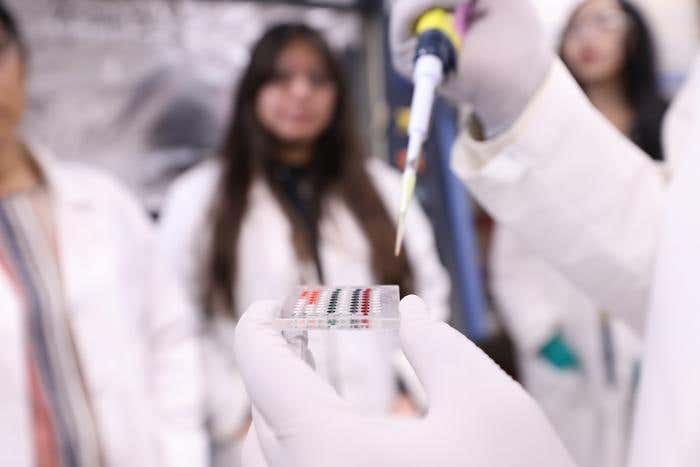Early and accurate cancer detection now possible with $4 paper-based device
A team has built a low-cost paper-based cancer test that detects disease in under an hour—no lab equipment required.

A new device detects cancer in just one hour using paper and plastic, offering fast, cheap testing with no lab tools needed. (CREDIT: UTEP)
A new kind of cancer test could soon change how doctors detect deadly diseases—quickly, cheaply, and almost anywhere. A team of researchers has designed a small, low-cost device that can identify cancer markers in just one hour, using simple materials like paper and plastic. This powerful invention could help save lives by catching cancer early, especially in places where medical equipment is hard to get.
A Smarter Way to Spot Cancer
Traditional cancer tests often take more than half a day to complete. The most common method, called ELISA, requires expensive machines, a large amount of fluid, and skilled workers. It’s reliable, but slow and costly. In rural areas or countries with fewer resources, these delays can become deadly. People often have to wait days or even weeks to get results, losing valuable time during which the cancer may spread.
“If you can detect biomarkers early on, before the cancer spreads, you increase a patient’s chance of survival,” said Dr. XiuJun (James) Li, the lead researcher on the project from the University of Texas at El Paso. “Any delays in testing, especially in regions that don’t have access to expensive tools and instruments, can be very bad for a patient’s prognosis.”
The new invention changes that. Called a paper-in-polymer-pond, or PiPP device, this hybrid tool can check for signs of cancer faster and more accurately than most current methods.
How the PiPP Device Works
The PiPP device uses tiny amounts of blood to look for cancer markers. These are proteins in the blood that suggest cancer may be present. The key to this device is its clever use of materials. It has layers of clear plastic, with small wells or ponds where samples go. Inside those wells, the team placed pieces of chromatography paper that were specially prepared to catch cancer markers.
When a blood sample touches the paper, any cancer markers in the sample attach to it. The paper changes color depending on what proteins are found. A deeper color means more of the protein is present, helping doctors know how far the cancer may have progressed.
Related Stories
Instead of needing expensive machines, the color of the paper can be checked with a regular office scanner or a smartphone camera. The device doesn’t just match the abilities of traditional tests—it goes beyond them. It can detect much smaller amounts of cancer markers, which is important for finding cancer early.
The test detected two common cancer markers—carcinoembryonic antigen (CEA) and prostate-specific antigen (PSA)—at levels ten times lower than standard ELISA kits. Specifically, it found CEA at 0.32 nanograms per milliliter and PSA at 0.20 nanograms per milliliter. That’s a major leap in sensitivity, all without specialized lab tools.
Faster, Cheaper, and Reusable
Speed isn’t the only benefit. The PiPP device is reusable. After one test, you can replace just the paper part, not the whole tool. This makes it even more affordable. Each test costs only a few dollars to run, compared to much higher prices for commercial kits.
“Dr. XiuJun Li's innovation significantly improves point-of-care diagnostics by reducing detection times and the need for costly instruments,” said Robert Kirken, dean of the College of Science. “This makes it ideal for resource-limited settings, which will improve early diagnosis and lead to better cancer outcomes.”
Reagents—the liquids that help the test work—can easily be added from the top layer of the device. They flow through to the paper in the wells below without the need for high-end machines. This simple design reduces human error, saves time, and gets more reliable results.
Doctors can perform many tests at once using this device, which makes it useful in large clinics or during outbreaks where quick screening is key. Because it uses such small volumes, the PiPP method also reduces waste and cost, which helps clinics with limited resources.
Bringing Early Detection to Everyone
One of the biggest advantages of the PiPP device is that it brings medical testing to places that have never had it before. In many parts of the world, hospitals and labs don’t have the tools to run ELISA tests. Even when they do, the cost and time involved often stop people from getting tested.
“Our new biochip device is low-cost — just a few dollars — and sensitive, which will make accurate disease diagnosis accessible to anyone, whether rich or poor,” said Dr. Li. “It is portable, rapid and eliminates the need for specialized instruments.”
This device doesn’t require electricity or trained lab workers to operate. That makes it perfect for remote clinics, mobile health units, and even home use someday. All that’s needed is a small blood sample, a smartphone, and the PiPP device.
While the study focused on prostate and colorectal cancer, the method could be adapted for many other diseases. With more research, it could be used to test for breast, lung, or liver cancer—or even for infectious diseases that need fast diagnosis, like COVID-19 or malaria.
What’s Next Before It Reaches Patients
Before this life-saving device becomes widely available, it must pass several more steps. The team needs to complete a working prototype, run clinical trials with real patients, and get approval from health authorities like the Food and Drug Administration.
Those steps could take a few more years. But the results so far offer hope to millions of people worldwide who face delays in cancer diagnosis because of cost or distance.
This new invention shows that smart science doesn’t always need fancy tools. Sometimes, a piece of paper and clear thinking are all it takes to fight one of the world’s deadliest diseases.
Revolutionizing Cancer Testing with a Simple Device
This paper-based device offers a way to screen for cancer quickly and cheaply using tools nearly everyone already has. By making early detection easier, faster, and more affordable, it could help change how the world fights cancer. And it all starts with a single drop of blood.
Research findings are available online in the journal Lab on a Chip.
Note: The article above provided above by The Brighter Side of News.
Like these kind of feel good stories? Get The Brighter Side of News' newsletter.



